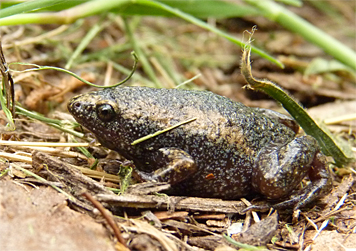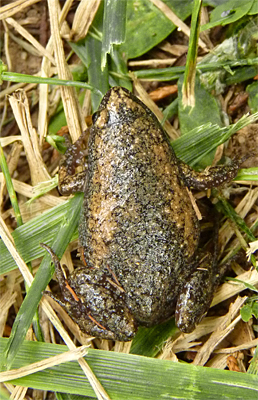For the past two years I’ve heard Eastern Narrowmouth Toads (Gastrophryne carolinensis) calling from in and around the Wetlands. I’ve even heard them call from the area surrounding the small U-shaped pond in Catch the Wind but had not been able to actually see one of the tiny toads. Sure, each year I do happen to see one of their 10 mm sized young hopping away from the pond after metamorphosing from tadpole to toad, but had not seen an adult, until now.
Thanks to one of the kids in Summer Camp here at the Museum, who, in his search for insects next to the Wetlands, spotted and captured one of these 1.25 inch (about 30 mm) amphibians. The kids thought the toad a frog and were very excited when I happened along and told them that it was in fact a toad, at least in name.
Both the common and scientific names of this secretive amphibian contain the word toad. Eastern Narrowmouth Toad refers to the facts that it lives in the east and has a narrow, pointed head and mouth. The Latinized Gastrophryne carolinensis means belly toad of Carolina (gastro=belly, phryne=toad, carolinensis=you guessed it, of Carolina).

These little toads are not true toads like the American Toad or Fowler’s Toad but belong to a wide ranging family of frogs known as Microhylidae which suggest that they are small treefrogs (micro=small, hyla=tree). However, they spend most of their time in burrows, under logs, or in the leaf litter.

Narrowmouth toads eat ants, among other small insects. The toads secrete a toxic substance from their skin which may help protect them from the bites of their prey. This secretion may also irritate your skin and eyes if you’re not careful in handling these toads, so wash your hands after picking one up, that is if you’re lucky enough to see one.
Now that you have seen one and know where to look do you think your odds are better for seeing more?
Actually, no. I knew where and when to look previous to this sighting. The best time for seeing an adult is at night during June when they’re breeding.
If it wasn’t for the young summer camper here at the Museum who spotted and captured the little toad, I’d probably still be looking for one. I’m sure that if a systematic search was conducted, a few Eastern Narrowmouth Toads could be tracked down during daylight hours in June when I typically hear them calling on cloudy or rainy days.
As I mentioned in the post, I usually see one of the young later in the year, around September, as they emerge from the water for the first time after metamorphosing from tadpole to toad, but there’s no guarantee of that either.
But, perhaps the most fun part about coming across this tiny toad is the same reason why spending time in Explore the Wild is so much fun, you never know what and when something interesting is going to pop up. Your odds of seeing any given creature are definitely increased in the correct habitat and at the right time of the year, but you really never know what you’ll find from day to day out there in the “Wild.”
Thanks,
“Toad”, not “frog”, sorry!
You may be right about that. As far as the true toads are concerned, there does seem to be some correlation between the size of the toad and the pitch of their call.
Listen to the largest (an introduced species here in the US), the Cane Toad (Bufo Marinus):
http://www.environment.nsw.gov.au/resources/pestsweeds/canetoad.mp3
And the smallest, the Oak Toad (Bufo quercicus):
http://www.uga.edu/srelherp/anurans/bufque.mp3
The three mid-sized toads in our area are rather close together in pitch.
American Toad (Bufo americanus): http://www.herpsofnc.org/herps_of_NC/anurans/Bufame/American%20Toad.mp3
Southern Toad (Bufo terrestris): http://www.herpsofnc.org/herps_of_NC/anurans/Bufter/Southern%20Toad.mp3
and
Fowler’s Toad (Bufo fowleri): http://www.herpsofnc.org/herps_of_NC/anurans/Buffow/Fowler%27s%20Toad.mp3
The size differences are slight in the above three toads, but they are listed here from the largest to smallest according to average measurements.
Do you know if the differences in pitch of their call denote differences in the size of their bodies? (Higher pitch, smaller frogs, maybe?)